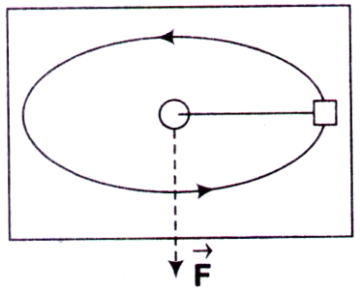A mass m is connected on either side with a spring each of spring constants k1 and k2. The free ends of springs are tied to rigid supports. The displacement of the mass is x from equilibrium position.

Which one of the following is true?
A. The force acting on the mass is $${\left( {{k_1}{k_2}} \right)^{\frac{1}{2}}}x$$
B. The angular momentum of the mass is zero about the equilibrium point and its Lagrangian $$\frac{1}{2}m{{\dot x}^2} - \frac{1}{2}\left( {{k_1} + {k_2}} \right){x^2}$$
C. The total energy of the system is $$\frac{1}{2}m{{\dot x}^2}$$
D. The angular momentum of the mass is $$mx\dot x$$ and Lagrangian of system is $$\frac{m}{2}\dot x + \frac{1}{2}\left( {{k_1} + {k_2}} \right){x^2}$$
Answer: Option B
A. increases till mass falls into hole
B. decreases till mass falls into hole
C. remains constant
D. becomes zero at radius r1, where 0 < r1 < r0
A. $$\frac{c}{3}$$
B. $$\frac{{\sqrt 2 }}{3}c$$
C. $$\frac{c}{2}$$
D. $$\frac{{\sqrt 3 }}{2}c$$
The Hamiltonian corresponding to the Lagrangian $$L = a{{\dot x}^2} + b{{\dot y}^2} - kxy$$ is
A. $$\frac{{{p_x}^2}}{{2a}} + \frac{{{p_y}^2}}{{2b}} + kxy$$
B. $$\frac{{{p_x}^2}}{{4a}} + \frac{{{p_y}^2}}{{4b}} - kxy$$
C. $$\frac{{{p_x}^2}}{{4a}} + \frac{{{p_y}^2}}{{4b}} + kxy$$
D. $$\frac{{{p_x}^2 + {p_y}^2}}{{4ab}} + kxy$$
A. circular
B. elliptical
C. parabolic
D. hyperbolic


Join The Discussion